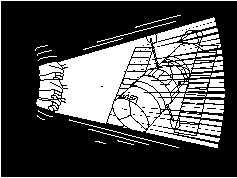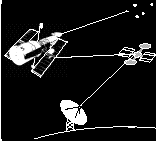Slide projector
Color slide of clearly defined objects
such as Saturn, a building, etc.
1/2 inch dowel, 3 feet long
Sheet of white paper
White paint (flat finish)
Dark room
Procedure:
1. Paint the dowel white and permit it to dry. (A piece of 3/4 inch pvc water pipe from a hardware store can substitute for the dowel and white paint, and so can a meter stick.)
2. Set up the slide projector in the back of the classroom and focus the image of the slide at a distance of about 4 meters away from the projector. Hold up the sheet of paper in the beam at the proper distance for easy focusing. Be sure the focus point you selected is in the middle of the room and not near a wall.
3. Arrange the students between the focus point and the projector. Darken the room. Hold the dowel in one hand and slowly move it up and down through the projector beam at the focal point. Ask the students to try to identify the image that appears on the dowel.
4. Gradually, increase the speed of the dowel's movement.
5. When the dowel moves very fast, the image becomes clear.

Discussion:
Because astronomy spacecraft operate in space for many years, the data they collect cannot be recorded on camera film. There is simply no easy way to deliver the film to Earth for processing. Rather, the satellite instruments collect light from objects and divide it into discrete bits of information and radio them to Earth as a series of binary numbers. This activity demonstrates how images can be divided into many parts and then reassembled into a recognizable picture. By slowly moving the dowel across the slide projector's beam, small fragments of the image are captured and reflected (RradioedS) towards the students. Because more and more fragments are sent as the dowel is moved, the image quickly becomes confused in the student's minds. However, as the rod is moved more rapidly, an important property of the eye and brain connection comes into play; light images are momentarily retained. This property is called persistence of vision. As the dowel's
